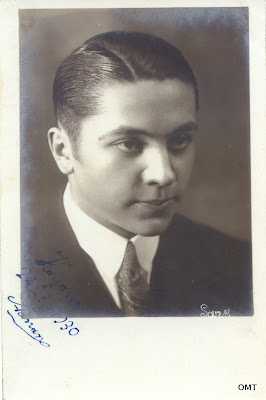Glamour portraits from a forgotten Constantinople studio
Every gal in Constantinople
Lives in Istanbul, not Constantinople
So if you've a date in Constantinople
She'll be waiting in Istanbul
Lives in Istanbul, not Constantinople
So if you've a date in Constantinople
She'll be waiting in Istanbul
In the 1930s a visit to the photo studio was still a social event, the way it had been since the invention of the carte de visite in the 1860s. Armenians and Greeks still dominated commercial photography in Istanbul – which had its name changed from Constantinople in 1930 – and according to some sources one of the busiest times for studios was on a Sunday after church services, when people were in their best clothes and a relaxed frame of mind. They would head off to the studio together and among tea and cakes discuss such matters as lighting and the angle of the face.
These portraits come from the Șark photo studio in Harbiye, Constantinople, and they are so distinctive they deserve a post on their own. Information on the studio is sparse but the name tells us something. Pronounced ‘shark’, it is a literary term for ‘the orient’ and not in common usage, although Pascal Sebah had called his studio El Chark – same word, different spelling – in the 1870s. ‘Orient’ might sound to us like a logical choice for a Turkish studio but it would be similar to westerners referring to themselves as occidentals, which they’d only do if they wanted to annoy people. Educated professionals in Constantinople would have understood the reference in Șark but a lot of people wouldn’t have known what the word meant.
There are hundreds of vanity portraits in the collection but few show this photographer’s facility for creating mood through lighting. The obvious source was the glamour photography coming out of the cinema in Europe and the U.S, something his subjects were au fait with too since they knew how to pose like hoodlums, heartthrobs and all round gentlemen of style. They could easily be actors. All that makes them interesting and worthy of a post, but there’s more.
Most of them have the same name inscribed on them; Șükrü Kaya’ and are dated between March and April, 1930. Some of them still have the brown corner tabs where they were posted into an album. The way his name is written; ‘Șükrü Kayaya’, can mean ‘for Șükrü Kaya’. Whoever he was and why he collected so many portraits are just more questions we’ll never have the answers to though there’s no harm in considering some possibilities. A Șükrü Kaya held various ministries including Foreign Affairs during the Ataturk Era; in 1930 he was Minister of the Interior. That would suggest the men in these photos were all civil servants, which they don’t really look like since portraiture of government officials generally went for the stiff, ominous look. But we can dismiss the notion this was the Șükrü Kaya. Technically speaking, in 1930 he didn’t exist, not by that name anyway.
These photos were signed three years before the law compelling Turkish people to formally take surnames was introduced. At this point, Turks outside the higher echelons of government sometimes adopted surnames referring to their jobs, their father or a trait but they were unofficial and flexible so someone could conceivably be known by several surnames depending on who was addressing them. Kaya means rock, with all its attendant metaphors – solid, dependable, you are my anchor in a storm and so on. It became a popular official surname after 1933 but for 1930 it would have been a nickname, which makes sense yet it is still curious.
My guess is that Șükrü Kaya was a friend of these people, like them in his early or mid twenties, which would make him a student most likely. It was a touching gesture for all his friends to head off to Șark to have their portraits taken as a memento, something we wouldn’t think of today. Maybe he was getting married. Maybe he paid for everyone’s portrait. A lot of maybes and even more don’t knows.
There are ten portraits here. All of them have the Șark look. There were hundreds of photo studios operating in Constantinople at the time. Most of their details have been lost and forgotten, which is too bad because if Șark had been based in a lot of other countries its records would have been preserved somewhere.
 |
| SARK STUDIO |







No comments:
Post a Comment
Add comments here